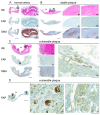Evaluation of the radiolabeled boronic acid-based FAP inhibitor MIP-1232 for atherosclerotic plaque imaging
- PMID: 25633335
- PMCID: PMC6272135
- DOI: 10.3390/molecules20022081
Evaluation of the radiolabeled boronic acid-based FAP inhibitor MIP-1232 for atherosclerotic plaque imaging
Abstract
Research towards the non-invasive imaging of atherosclerotic plaques is of high clinical priority as early recognition of vulnerable plaques may reduce the incidence of cardiovascular events. The fibroblast activation protein alpha (FAP) was recently proposed as inflammation-induced protease involved in the process of plaque vulnerability. In this study, FAP mRNA and protein levels were investigated by quantitative polymerase chain reaction and immunohistochemistry, respectively, in human endarterectomized carotid plaques. A published boronic-acid based FAP inhibitor, MIP-1232, was synthetized and radiolabeled with iodine-125. The potential of this radiotracer to image plaques was evaluated by in vitro autoradiography with human carotid plaques. Specificity was assessed with a xenograft with high and one with low FAP level, grown in mice. Target expression analyses revealed a moderately higher protein level in atherosclerotic plaques than normal arteries correlating with plaque vulnerability. No difference in expression was determined on mRNA level. The radiotracer was successfully produced and accumulated strongly in the FAP-positive SK-Mel-187 melanoma xenograft in vitro while accumulation was negligible in an NCI-H69 xenograft with low FAP levels. Binding of the tracer to endarterectomized tissue was similar in plaques and normal arteries, hampering its use for atherosclerosis imaging.
Conflict of interest statement
The authors declare no conflict of interest.
Figures





Similar articles
-
Cannabinoid receptor type 2 (CB2) as one of the candidate genes in human carotid plaque imaging: Evaluation of the novel radiotracer [11C]RS-016 targeting CB2 in atherosclerosis.Nucl Med Biol. 2017 Apr;47:31-43. doi: 10.1016/j.nucmedbio.2017.01.001. Epub 2017 Jan 8. Nucl Med Biol. 2017. PMID: 28104528
-
Fibroblast activation protein is induced by inflammation and degrades type I collagen in thin-cap fibroatheromata.Eur Heart J. 2011 Nov;32(21):2713-22. doi: 10.1093/eurheartj/ehq519. Epub 2011 Feb 2. Eur Heart J. 2011. PMID: 21292680 Free PMC article.
-
Gene expression levels of matrix metalloproteinases in human atherosclerotic plaques and evaluation of radiolabeled inhibitors as imaging agents for plaque vulnerability.Nucl Med Biol. 2014 Aug;41(7):562-9. doi: 10.1016/j.nucmedbio.2014.04.085. Epub 2014 Apr 21. Nucl Med Biol. 2014. PMID: 24853402
-
Fibroblast activation protein-α in fibrogenic disorders and cancer: more than a prolyl-specific peptidase?Expert Opin Ther Targets. 2017 Oct;21(10):977-991. doi: 10.1080/14728222.2017.1370455. Epub 2017 Aug 30. Expert Opin Ther Targets. 2017. PMID: 28829211 Review.
-
Fibroblast activation protein in liver fibrosis.Front Biosci (Landmark Ed). 2019 Jan 1;24(1):1-17. doi: 10.2741/4706. Front Biosci (Landmark Ed). 2019. PMID: 30468644 Review.
Cited by
-
Imaging of Fibroblast Activation Protein in Cancer Xenografts Using Novel (4-Quinolinoyl)-glycyl-2-cyanopyrrolidine-Based Small Molecules.J Med Chem. 2021 Apr 8;64(7):4059-4070. doi: 10.1021/acs.jmedchem.0c02171. Epub 2021 Mar 17. J Med Chem. 2021. PMID: 33730493 Free PMC article.
-
Targeting of activated fibroblasts for imaging and therapy.EJNMMI Radiopharm Chem. 2019 Jul 25;4(1):16. doi: 10.1186/s41181-019-0069-0. EJNMMI Radiopharm Chem. 2019. PMID: 31659499 Free PMC article. Review.
-
The Superiority of Fibroblast Activation Protein Inhibitor (FAPI) PET/CT Versus FDG PET/CT in the Diagnosis of Various Malignancies.Cancers (Basel). 2023 Feb 13;15(4):1193. doi: 10.3390/cancers15041193. Cancers (Basel). 2023. PMID: 36831535 Free PMC article. Review.
-
Clinical summary of fibroblast activation protein inhibitor-based radiopharmaceuticals: cancer and beyond.Eur J Nucl Med Mol Imaging. 2022 Jul;49(8):2844-2868. doi: 10.1007/s00259-022-05706-y. Epub 2022 Jan 31. Eur J Nucl Med Mol Imaging. 2022. PMID: 35098327 Free PMC article. Review.
-
Monitoring Therapeutic Response to Anti-FAP CAR T Cells Using [18F]AlF-FAPI-74.Clin Cancer Res. 2022 Dec 15;28(24):5330-5342. doi: 10.1158/1078-0432.CCR-22-1379. Clin Cancer Res. 2022. PMID: 35972732 Free PMC article.
References
-
- Ylä-Herttuala S., Bentzon J.F., Daemen M., Falk E., Garcia-Garcia H.M., Herrmann J., Hoefer I., Jukema J.W., Krams R., Kwak B.R., et al. Stabilisation of atherosclerotic plaques. Position paper of the european society of cardiology (ESC) working group on atherosclerosis and vascular biology. Thromb. Haemost. 2011;106:1–19. doi: 10.1160/TH10-12-0784. - DOI - PubMed
-
- Van der Wal A.C., Becker A.E., van der Loos C.M., Das P.K. Site of intimal rupture or erosion of thrombosed coronary atherosclerotic plaques is characterized by an inflammatory process irrespective of the dominant plaque morphology. Circulation. 1994;89:36–44. doi: 10.1161/01.CIR.89.1.36. - DOI - PubMed
-
- Galis Z.S., Khatri J.J. Matrix metalloproteinases in vascular remodeling and atherogenesis: The good, the bad, and the ugly. Circ. Res. 2002;90:251–262. - PubMed
Publication types
MeSH terms
Substances
LinkOut - more resources
Full Text Sources
Other Literature Sources
Medical
Miscellaneous

